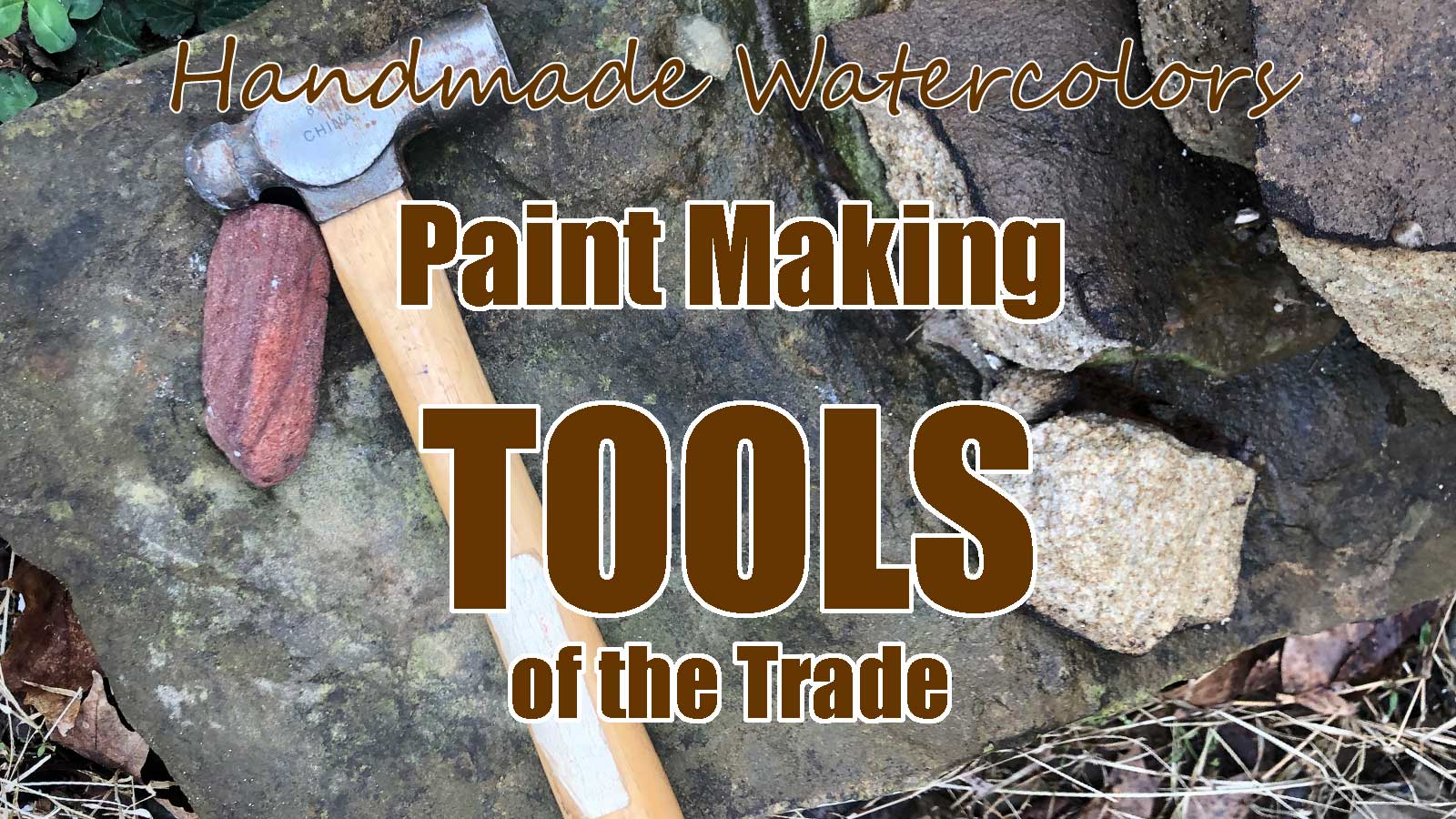Update 2024: I have a page at my online shop with my affiliate links for the paint making tools of the trade that I use from Amazon, and hopefully soon some of the other places I use, like Dick Blick. If you click through and order anything, I’ll get a small commission but it doesn’t affect the price you pay. I only list the things I’ve used and am satisfied with, and any exceptions to that are noted in the item caption.
When I first started experimenting with handmade watercolors, I didn’t have any special tools. I had some ideas, a little bit of information, and a whole lot of curiosity. Along the way I discovered these things that have become my paint making tools of the trade.

Making Do
Some of the tools are pricey, and if you went out and bought everything at once, it could add up to quite a hefty tab.
Thankfully, you don’t need it all, and you can make do with a bare minimum.
Here’s the post that marked my first time making art with my fresh idea for making my own paints.
These are the things I’d suggest as minimal:
- spatulas
- mulling plate
- pans
- small jars
- dust masks – VERY important!
- gum Arabic
A note about the mulling plate. When you first get it, the surface will be smooth. That won’t do for mulling paint. So you’ll need to run several trial batches on it with a gritty pigment to etch the surface enough to be able to actually do any good with your mulling. If you don’t want to waste valuable pigment, use coarse rubbing compound to get it started.
Leveling Up
After you’ve made some paint and tried out the process, you’ll know whether or not you like the paints enough to keep using them. That’s when I’d suggest getting a tool like the muller. There are also much more expensive mulling plates, or boards. I am still using my inexpensive 12″ x 14″ tempered glass cutting plate from Walmart, but wouldn’t turn down a large slab of marble, lol.
Update 6/2021: Our local marble and granite shop has a scrap pile, and they let people take scraps for free. My ‘scrap’ is a nice 16″ x 29″ slab of white marble! It works fantastic as a mulling board, but it has to stay in place on the table. Very heavy. This is now my # 1 paint making tool out of everything I’ve ever bought. I can also use the large muller I’d accidentally bought when I thought ‘bigger was better’. And it really is, now that I have a big enough mulling board to use it on.
My Favorite Paint Making Tools (So Far)
Some of these items are only applicable if you intend to start with foraged rocks or bought mineral specimens to make paint. Those are marked with an asterisk.
Notice: As an Amazon Associate I earn from qualifying purchases. What that means is that I’ll make a few pennies if you buy certain things after following the [ad] links in the sections below. The prices of those items are the same as they are if you went to Amazon on your own.
- Hammer
- Safety Glasses
- Mulling Plate
- Muller
- Spatulas
- 20-ml Vials* [ad]
- Pipettes
- Mortar and Pestle*[ad]
- Sifter/Strainer
- to hold paint, use acorn caps, clam shells, etc. if you’d rather not buy pans
- small jars[ad]
- reusable dust mask[ad]
- gum Arabic[ad]
You can often find mullers used or less expensive on EBay.
Future Paint Making Tools
There are a couple of items I’d like to acquire in the future. A larger rock tumbler/rock grinder and a roller mill. I’d need to start making much larger quantities of paints (and accompanying sales) to make those practical buys!
Update 06/2021: My husband bought me a prospector’s rock crusher – I call it my Phenomenal Rock Crushing Machine. It is awesome, but not a small investment. Read more about it here. I still would like to have the roller mill, but it’ll be a while yet before that one manifests.
My Other Posts About Making Handmade Watercolor Paint
Read this one if you’d like to know How to Identify Pigment Rocks
Before you start making paint, you’ll need to know How to Make Binder/Media
For a refined end result, here’s How to Make SMOOTH Paint from Rocks
ABOUT
________________________________
Madison Woods is the pen-name for my creative works. I’m a self-taught artist who moved to the Ozarks from south Louisiana in 2005. My paintings of Ozark-inspired scenes feature lightfast pigments from Madison county, Arkansas. My inspiration is nature – the beauty, and the inherent cycle of life and death, destruction, regeneration, and transformation.
Roxann Riedel is my real name. I’m also salesperson for Montgomery Whiteley Realty. If you’re interested in buying or selling in Madison or Carroll county, AR, let me know! You can see the properties that I blog about at WildOzarkLand.com.
Wild Ozark is also the only licensed ginseng nursery in Arkansas. Here’s the link for more information on the nursery
P.S.
There’s always a discount for paintings on the easel 😉
Here’s my Online Portfolio
And, Click here to join my mailing list.
Contact Mad Rox: (479) 409-3429 or madison@madisonwoods and let me know which hat I need to put on 🙂 Madison for art, Roxann for real estate, lol. Or call me Mad Rox and have them both covered!
https://www.youtube.com/@wildozark



Leave a Reply